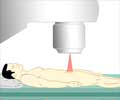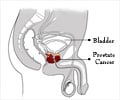A large multi-center clinical trial found a new PSA test screen for prostate cancer more accurately identified men with prostate cancer, particularly the aggressive form of the disease.

PSA stands for prostate-specific antigen, a substance whose elevated levels can indicate prostate cancer but can also be caused by prostate inflammation or enlargement or other conditions. Its lack of specificity can result in unnecessary biopsies.
"This new test is more specific and accurate than the currently available blood tests for early prostate cancer detection," said lead investigator William Catalona, M.D., director of the clinical prostate cancer program at the Robert H. Lurie Comprehensive Cancer Center of Northwestern University. "This will focus on the detection of more life-threatening prostate cancers and reduce unnecessary biopsies in men 50 years of age and older."
Catalona, known as the father of the PSA screening, was the first to show in 1991 that a simple blood test measuring PSA levels could be used to detect prostate cancer. He is a professor of urology at Northwestern's Feinberg School of Medicine and a urologist atNorthwestern Memorial Hospital.
The study, which will be published in the May issue of the Journal of Urology, followed 900 patients from 10 sites, including Northwestern. The results showed the new screening test, a simple blood test called the Pro-PSA test, is particularly useful for patients with a normal prostate exam whose PSA is 2 to 10, a range considered thediagnostic gray zone because most men with higher levels have prostate cancer and most men with lower levels do not.
The Pro-PSA test measures a more specific PSA subform called (-2) Pro-PSA. The test becomes even more accurate when its results are analyzed with a mathematical formula that provides an overall Prostate Health Index. (The formula divides the Pro-PSA number by the free-PSA. Then the quotient of the two is multiplied by the square root of the total PSA. )
Advertisement
The new Pro-PSA test was recently approved for commercial use in Europe, Catalona noted. "The FDA is currently reviewing our data from the study, and I'm hopeful that it will be approved in the United States as well," he said.
Advertisement


![Prostate Specific Antigen [PSA] & Prostate Cancer Diagnosis Prostate Specific Antigen [PSA] & Prostate Cancer Diagnosis](https://images.medindia.net/patientinfo/120_100/prostate-specific-antigen.jpg)











